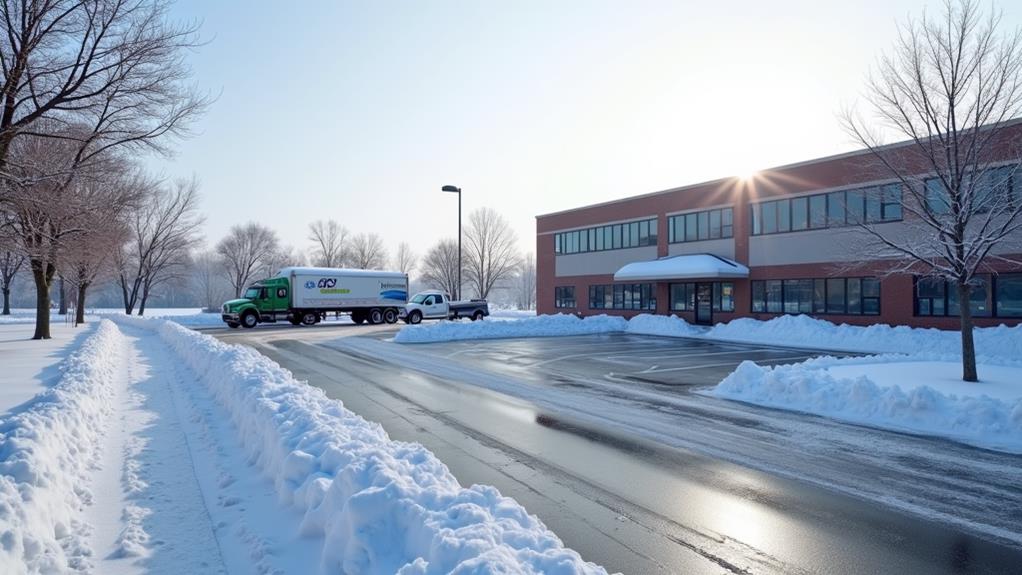
Table Of Contents
Snow Melting Systems
Snow melting systems are increasingly popular for managing winter weather challenges. These systems operate by using heated cables or wires installed beneath the surface of driveways, walkways, and even parking lots. When activated, they effectively melt snow and ice, preventing build-up and creating safer conditions for both pedestrians and vehicles.
For businesses and property owners, the importance of snow removal from parking lots cannot be overstated. Efficient snow melting systems not only enhance accessibility but also reduce the need for manual snow removal efforts. This can result in cost savings over time, as the system minimizes potential liabilities associated with snow and ice-related accidents.
How They Work
Snow melting systems utilize an integrated network of heating cables or hydronic tubing installed beneath surfaces such as driveways, sidewalks, and parking lots. When activated, these systems produce heat that melts snow and ice upon contact. The heat can be generated through electric currents or a heated liquid solution, ensuring that surfaces remain clear even during heavy snowfall. This technology aims to minimize the manual labor often associated with traditional snow removal methods.
In terms of application, snow removal from parking lots is particularly effective with these systems, as it eliminates the need for heavy machinery and reduces the risk of damage to the underlying surface. Additionally, the consistent heating prevents the accumulation of ice, enhancing safety for vehicles and pedestrians. This proactive approach allows for continuous operation, providing peace of mind during winter storms while also promoting longer-lasting infrastructure.
EcoFriendly Snow Removal Solutions
Eco-friendly snow removal solutions prioritize sustainability while effectively managing snow and ice. One approach involves using biodegradable de-icing agents, which minimize environmental impact compared to traditional salt-based chemicals. These agents are designed to be less corrosive and more beneficial for surrounding vegetation and water bodies. In urban areas, innovative snow removal methods, such as using heated pavement systems, provide a way to prevent accumulation without the need for chemical treatments.
Another eco-conscious strategy includes employing alternative equipment for snow clearing. Electric snow plows and snow blowers offer a cleaner option than their gas-powered counterparts, as they produce no emissions and reduce noise pollution. Additionally, using snow management practices in parking lots, such as thoughtful planning of snow piles to allow for natural melting, can help maintain safety without relying heavily on chemical treatments. Exploring these options can enhance the effectiveness of snow removal from parking lots while supporting environmental health.
Sustainable Practices to Consider
Incorporating sustainable practices into snow removal can greatly reduce environmental impact. Options such as using biodegradable de-icing materials help mitigate chemical runoff that can harm local ecosystems. Another way to promote sustainability is by minimizing the use of heavy machinery. By opting for manual snow clearing methods, particularly in smaller areas, resources are conserved and the carbon footprint is significantly lowered.
Snow removal from parking lots can also benefit from a more eco-conscious approach. Installing permeable pavement allows for better drainage of melting snow, reducing accumulation in drainage systems and minimizing flood risks. Additionally, incorporating landscaping with native plants around parking areas can further enhance absorption of runoff, creating a more sustainable urban environment. These practices not only address immediate snow removal needs but also contribute to overall environmental health.
Cost Comparison of Snow Removal Methods
When considering different options for snow removal methods, the costs can vary significantly based on the approach taken. Traditional plowing services often charge by the hour or per visit, which can add up throughout the winter months. For those managing larger spaces, such as commercial properties or shopping centers, Snow Removal from Parking Lots becomes a key factor in determining overall expenses. Professional services may offer contracts for the entire season, allowing for more predictable budgeting.
In contrast, more modern solutions like snow melting systems require a higher initial investment but can lead to long-term savings. The operational costs of these systems revolve around energy consumption, which may fluctuate with changing fuel prices. Additionally, eco-friendly solutions, though often less expensive in the short term, might offer benefits like reduced environmental impact and lower liability risks due to safer walking and driving conditions. Evaluating each method's cost-effectiveness helps in making an informed decision tailored to specific needs.
Budgeting for Snow Maintenance
When planning for snow maintenance, it's essential to understand the costs associated with different methods. Whether opting for professional services or investing in equipment for DIY solutions, each choice comes with its own financial implications. Regular snow removal from parking lots is often a priority for businesses to ensure safety and accessibility. This can lead to increased costs if relying on external contractors; however, purchasing equipment may require a hefty initial investment but can pay off in the long run for large properties.
In addition to direct snow removal expenses, budget considerations should encompass de-icing materials, maintenance of snow removal equipment, and labor costs. Businesses also need to anticipate potential weather patterns and their snowfall intensity to avoid last-minute expenditures. Planning ahead allows for a more manageable budget and avoids unexpected financial strain during the winter months, ensuring that operations can continue smoothly despite adverse weather conditions.
FAQS
What are snow melting systems?
Snow melting systems are heating systems installed in driveways, walkways, and other outdoor areas that automatically melt snow and ice, reducing the need for manual snow removal.
How do snow melting systems work?
Snow melting systems typically use electric heating cables or hydronic tubing filled with warm water to generate heat. This heat is transferred to the surface, causing snow and ice to melt on contact.
What are eco-friendly snow removal solutions?
Eco-friendly snow removal solutions include using biodegradable de-icers, snow shovels, and hiring services that prioritize sustainable practices, such as minimizing carbon footprints and using environmentally safe products.
How can I budget for snow maintenance?
To budget for snow maintenance, consider the costs of various removal methods, including the upfront installation of snow melting systems, ongoing maintenance costs, and the price of hiring snow removal services. It's also important to factor in potential expenses for equipment and materials if you choose to manage snow removal yourself.
Which snow removal option is the most cost-effective?
The most cost-effective snow removal option can vary depending on your specific situation, including property size, climate, and personal preferences. While hiring a snow removal service may be less expensive upfront, investing in a snow melting system could save money over time by reducing labor and material costs.
